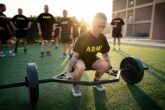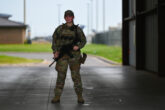November 11, 2022
What We’re Getting Wrong about Veterans
Combat is a glacier that envelops every aspect of a soldier’s life. You’re never the same after combat, but that doesn’t mean you’re broken. I had time to think about this as I pedaled over glacier-cut rivers during the 1,700-mile Fallen Hero Honor Ride, a cross-country bicycle trek to visit the graves of the six paratroopers from my Army unit who were killed in action in Afghanistan—and to raise support for the unit’s 800 veterans and families who need help.
Our nation’s veterans are entering the most dangerous days of their lives. Already, we’ve lost more to suicide and substance abuse than to enemy fire, and the situation will worsen in the coming years as veterans approach midlife. Twenty-two veterans die daily by suicide, and over 30,000 have done so since 9/11. This is a startling figure compared to the 7,000-plus soldiers who have been killed in wars since that time. Most soldiers who experience intense combat—where you’re killing and wounding and seeing people killed and wounded; where you’re urinating in tubes and defecating in barrels; where you face hardship, heartache, and heartbreak—are only 18 to 27 years old.
The memories of combat are loud bells that clang and gong in every veteran’s head unexpectedly. The emptier you feel, the more their crashing sounds echo and linger.
As a young soldier, you feel intense purpose and belonging. In your head, you think: I’m defending my country against people who seek to harm us. The person to my left and right get me; they’ve got my back, and I’ve got theirs. You believe the country is behind you. Many combat veterans look back to these days as the happiest of their lives.
But many people struggle after leaving the military. Purpose doesn’t feel the same when you’re punching the clock and making a buck. You don’t feel like you belong. In your head, you now find yourself thinking: The person to my left and right don’t get me, nobody’s got my back (and some try to stab me in it), and no one knows how to help. What good are service and sacrifice doing for me now?
You feel empty.
Read the full article from YFS Magazine.
More from CNAS
-
National Security Human Capital Program
Short SupplyExecutive Summary The U.S. military faces a critical challenge: Fewer young Americans are willing to serve, and fewer adults are encouraging them to do so. Because of delibera...
By Katherine L. Kuzminski & Taren Sylvester
-
National Security Human Capital Program
Defending the Army’s Command Assessment ProgramThe concept for CAP — developed during the first Trump administration — benefited from the guidance, input and oversight from the foremost scholar and practitioner on military...
By Katherine L. Kuzminski
-
National Security Human Capital Program
‘Women Don’t Just Achieve…They Excel’: Fmr. Marine Corps Attack PilotDr. Kyleanne Hunter, former Marine Corps attack pilot and CEO of Iraq & Afghanistan Veterans of America, says “women are the fastest growing group of veterans” and “the fastes...
By Dr. Kyleanne Hunter
-
National Security Human Capital Program
A Workforce Strategy for America’s Shipbuilding FutureThe future of American maritime dominance will not be determined solely by the number of ships launched or contracts signed, but rather by the strength and sustainability of t...
By Katherine L. Kuzminski & Laura Schmiegel




